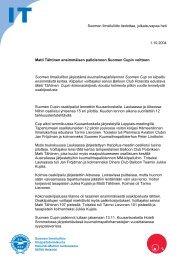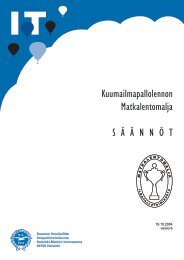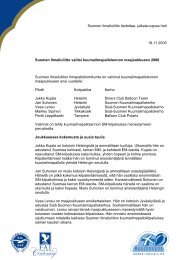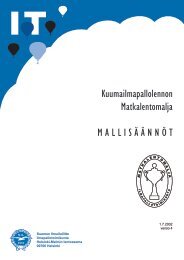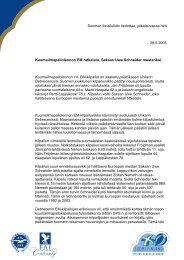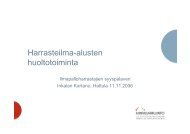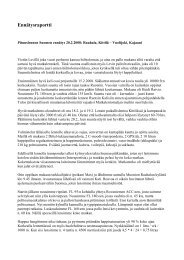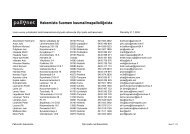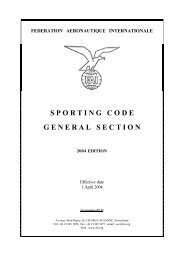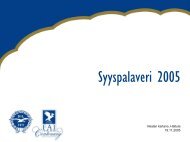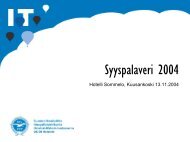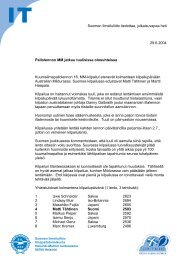You also want an ePaper? Increase the reach of your titles
YUMPU automatically turns print PDFs into web optimized ePapers that Google loves.
CIA COMPETITION OPERATION HANDBOOK<br />
9.16 OBSTRUCTION<br />
Obstruction is difficult to penalise. Actually a competitor obstructing other pilots with his<br />
inflated balloon while not waving a white flag, should be requested to deflate by the launch<br />
master. Therefore it is difficult to penalise a competitor if the launch master did not order<br />
him to deflate. Nevertheless in this case at least a warning should be given.<br />
9.17 TAKE-OFF PERMISSION<br />
Taking-off without permission should be penalised by a warning or 50 points in first<br />
instance and when no disruption of the Take-off process was caused. During a Take-off<br />
with many balloons and or when causing potential safety problems, this should be<br />
penalised between 100 and 250. However, if actual problems were observed or safety<br />
was actually impaired then the penalty should be from 250 to 500 points.<br />
9.22 CLEARING LAUNCH AREA<br />
A competitor should clear the launch area without undue delay (in 3 min or above 500ft).<br />
The penalty for infringing this rule should be a warning except when deliberate or when<br />
competition advantage was gained, then the penalty should be 100 points or more,<br />
depending on the advantage. In case of a minimum distance task, the penalty is fixed at<br />
100 points per min! (See rule 15.13.5)<br />
10.1 MIDAIR COLLISION AND RECKLESS FLYING<br />
The <strong>GPS</strong>-Loggers provide means to objectively determine what happened when climbing<br />
too fast or in case of a balloon collision and should be used in case of observed and/or<br />
reported collisions. As a reaction to multiple serious collisions during the WHABC 2006,<br />
the RSC at her meeting in 2007 decided to provide strong guidance how to treat collisions.<br />
Any collision other than trivial envelope ‘touches’ as under R10.1.4 Envelope to envelope<br />
contact in approximate level flight will generally not be penalized., should be considered<br />
dangerous and penalized. Generally the idea is the more forceful the higher the penalty.<br />
Also the principle should be that the one that could have avoided the problem best should<br />
be the harder penalised, which usually is the higher balloon. However this does not relieve<br />
to lower or climbing competitor from responsibility. In general one can presuppose that a<br />
pilot climbing fast in competition acknowledges responsibility for collisions. Should a pilot<br />
climbing at 10m/sec hit a level flying balloon then we would suggest 75% of responsibility<br />
with the climbing pilot and 25% with the level flying one. Should however a fast<br />
descending pilot hit a level flying pilot, the descending pilot should take 100%<br />
responsibility and likewise 100% of the penalty given.<br />
Although rather difficult and subjective, when possible the aspect off recklessness’s and<br />
irresponsibility should be addressed. If a competitor is a repeated offender he should be<br />
strongly penalised up the Disqualification.<br />
New competitors not used to fly in big events tend to not pay enough attention. This may<br />
addressed at the GB and should not be a reason to reduce a penalty.<br />
Taken al of the above into respect the SWG suggests the following penalty:<br />
Lower Balloon Higher Balloon<br />
VS m/s Penalty VS m/s Penalty<br />
1 Warning -1 200<br />
2 100 -2 400<br />
3 300 -3 600<br />
4 500 -4 800<br />
5 700 -5 1,000<br />
6 1,000 -6 1,000<br />
Version 2007 Page 30



